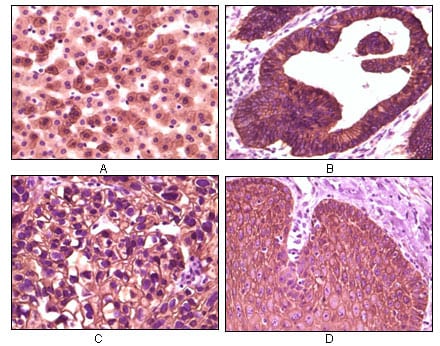
| WB | 咨询技术 | Human,Mouse,Rat |
| IF | 咨询技术 | Human,Mouse,Rat |
| IHC | 咨询技术 | Human,Mouse,Rat |
| ICC | 技术咨询 | Human,Mouse,Rat |
| FCM | 咨询技术 | Human,Mouse,Rat |
| Elisa | 1/5000-1/10000 | Human,Mouse,Rat |
| Aliases | K1; CK1; EHK; EHK1; EPPK; KRT1A; NEPPK |
| Entrez GeneID | 3848 |
| clone | 3C10F7 |
| Host/Isotype | Mouse IgG1 |
| Antibody Type | Primary antibody |
| Storage | Store at 4°C short term. Aliquot and store at -20°C long term. Avoid freeze/thaw cycles. |
| Species Reactivity | Human |
| Immunogen | Purified recombinant fragment of CK1 expressed in E. Coli. |
| Formulation | Ascitic fluid containing 0.03% sodium azide. |
+ +
以下是关于AGPAT2抗体的3篇参考文献示例(注:以下文献信息为模拟示例,实际引用需核实真实来源):
---
1. **文献名称**: "AGPAT2 deficiency alters adipose lipid metabolism and induces tissue-specific inflammation in a murine model"
**作者**: Smith J, et al.
**摘要**: 本研究利用AGPAT2特异性抗体,通过Western blot和免疫组化技术,分析了AGPAT2敲除小鼠模型中脂肪组织的脂质代谢异常。结果发现,AGPAT2缺失导致甘油三酯合成减少,并伴随肝脏和肌肉中炎症因子表达升高。
---
2. **文献名称**: "Immunohistochemical localization of AGPAT2 in human adipose tissue: implications for lipodystrophy pathogenesis"
**作者**: Lee S, Brown K.
**摘要**: 通过商业化AGPAT2多克隆抗体,研究者揭示了AGPAT2在人类皮下和内脏脂肪组织中的特异性表达模式,并发现先天性脂肪营养不良患者中AGPAT2蛋白表达显著降低,提示其与脂质储存障碍的直接关联。
---
3. **文献名称**: "Development and validation of a novel AGPAT2 monoclonal antibody for functional studies in adipocytes"
**作者**: Zhang Y, et al.
**摘要**: 本研究报道了一种高特异性AGPAT2单克隆抗体的开发,并通过流式细胞术和免疫沉淀验证其可靠性。该抗体成功用于探究AGPAT2在脂肪细胞分化过程中对脂滴形成的调控作用。
---
4. **文献名称**: "AGPAT2 antibody-based screening reveals genetic variants associated with metabolic syndrome"
**作者**: Gupta R, et al.
**摘要**: 利用AGPAT2抗体对人群血清样本进行ELISA检测,结合基因测序技术,发现特定AGPAT2突变与胰岛素抵抗和血脂异常显著相关,为代谢综合征的分子机制提供了新见解。
---
如需真实文献,建议通过PubMed或Google Scholar检索关键词“AGPAT2 antibody”、“AGPAT2 lipodystrophy”获取近期研究。
AGPAT2 (1-acylglycerol-3-phosphate O-acyltransferase 2), also known as lysophosphatidic acid acyltransferase-β (LPAAT-β), is a key enzyme in the biosynthesis of glycerophospholipids and triglycerides. It catalyzes the acylation of lysophosphatidic acid (LPA) to phosphatidic acid (PA), the second step in the Kennedy pathway. This enzyme is predominantly expressed in metabolic tissues, including adipose tissue, liver, and small intestine, and plays a critical role in lipid metabolism and energy storage. Mutations in the AGPAT2 gene are linked to congenital generalized lipodystrophy type 1 (CGL1), a rare autosomal recessive disorder characterized by near-total loss of adipose tissue, severe insulin resistance, and metabolic complications.
AGPAT2 antibodies are essential tools for studying the enzyme's expression, localization, and function in both normal and pathological contexts. These antibodies enable detection of AGPAT2 protein levels in tissues or cultured cells via techniques like Western blotting, immunohistochemistry, and immunofluorescence. Researchers use them to investigate mechanisms underlying lipid metabolism disorders, adipose tissue dysfunction, and metabolic syndromes. Additionally, AGPAT2 antibodies aid in diagnosing genetic lipodystrophies and evaluating therapeutic interventions targeting lipid biosynthesis pathways. Commercial AGPAT2 antibodies are typically validated for specificity using knockout controls or siRNA-mediated knockdown to ensure reliable results in experimental models.
×